AMD Radeon HD 7950 Review Feat. Sapphire & XFX: Sewing Up The High-End Market
by Ryan Smith on January 31, 2012 9:02 AM ESTPower, Temperature, & Noise
As always, we wrap up our look at a new video card with a look at the physical performance attributes: power consumption, temperatures, and noise. With the 7970 we saw what is possible with Tahiti when AMD is trying to maximize their performance, but how will things stack up with the lower power 7950? Let’s find out.
Please note that we’ve decided to include our reference 7950 in these charts, even though none of AMD’s partners will be shipping a card in this exact configuration. Typically we wouldn’t do this, but as our partner cards are overclocked it’s the only stock performance card we have. Furthermore it provides an interesting contrast to the 7970, since they’re built on the same hardware. With that said, the Sapphire and XFX cards are far more representative of the cooling performance you’ll see with retail cards.
| Radeon HD 7900 Series Voltages | |||||
| Ref 7970 Load | Ref 7950 Load | XFX 7950 Black Edition DD | Sapphire HD 7950 Overclock Edition | ||
| 1.17v | 1.093v | 1.093v | 0.993v | ||
Since the launch of the 7970 we’ve finally seen the release of tools that can read the VIDs of Tahiti GPUs. For our review we have four 7950s in our hands, and one of them is not like the others. Both of our AMD cards and our XFX card have a VID of 1.093v, however the Sapphire card is significantly lower. So low that we thought this was an error and went through 3 different tools just to be sure it wasn’t. Sure enough, our Sapphire 7950 does indeed ship at 0.993v, roughly 0.1v below our other 7950s and lower than what we thought Tahiti could operate at. The fact that the Sapphire is overclocked makes this all the more impressive, and we’ll see how this plays out in a moment.
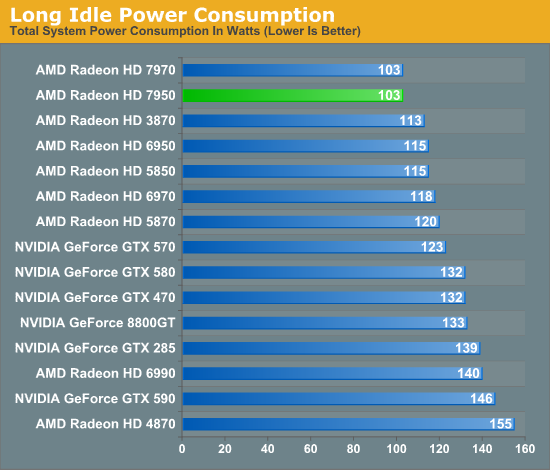
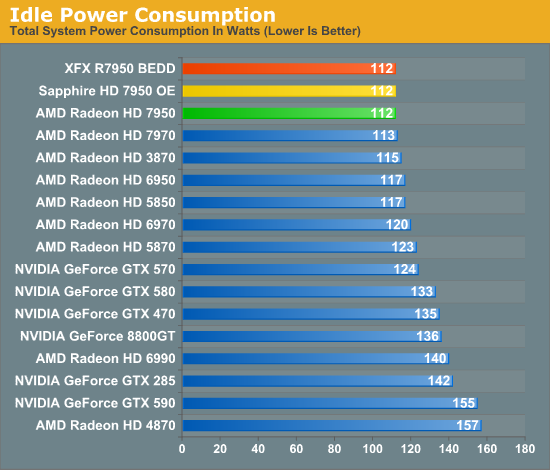
Starting as always with idle power, there aren’t many surprises here. Power islands not only give the 7000 series great idle power characteristics, but they also greatly diminish the difference between GPUs when it comes to idle power consumption. As a result the entire 7950 lineup is at 112W at the wall, consistently 1W below the 7970 and a good 20W below the GTX 580.
The situation with long idle power is much the same. As AMD’s ZeroCore power technology effectively powers down all the workhorse components of the GPU, the only thing left is a small constant load from the bus controller, giving us 103W on both the 7970 and 7950.
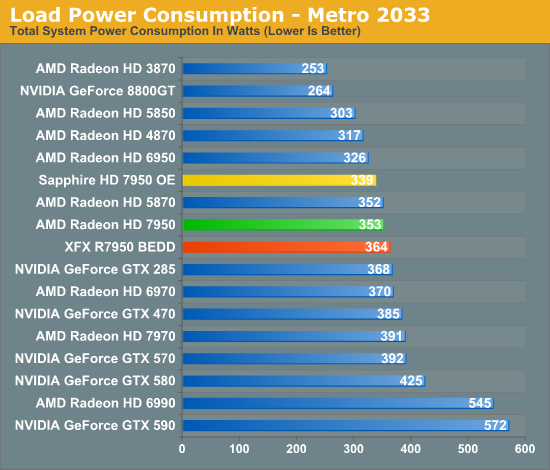
Meanwhile it’s under load that the physical performance attributes of the 7950 really begin to shine. Compared to the GTX 580, our 7950 equipped testbed draws 72W less at the wall; the performance advantage we saw in Metro earlier makes this all the more impressive. The 7950 also pulls less power than the 7970 here as we’d expect, leading to a difference of 38W at the wall.
As for our two partner cards, the Sapphire does particularly well here thanks to its very low VID, while the XFX does a bit worse than the reference 7950, likely due to its stock VID coupled with the factory overclock.
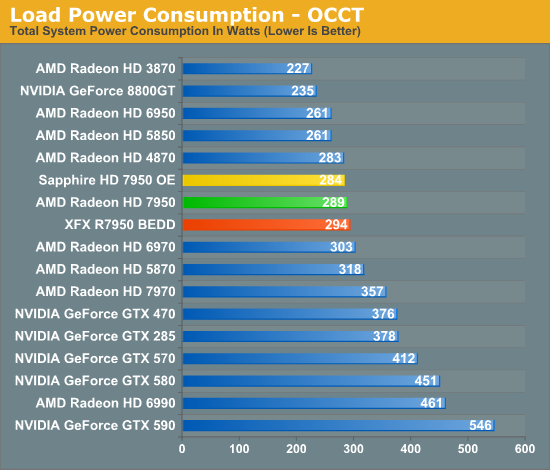
Under OCCT our 7950 cards begin to clump together in spite of their differences. With the reference 7950 at 289W, the Sapphire and XFX cards pull 5W less and 5W more respectively. It’s interesting to note here that as with the 7970 compared to the 6970, the 7950 is pulling more power than the 6950 even though both cards should have the same PowerTune limit. In practice it’s clear that the 7950 is more power hungry than the 6950 despite the PowerTune limit, so this needs to be taken into account accordingly.
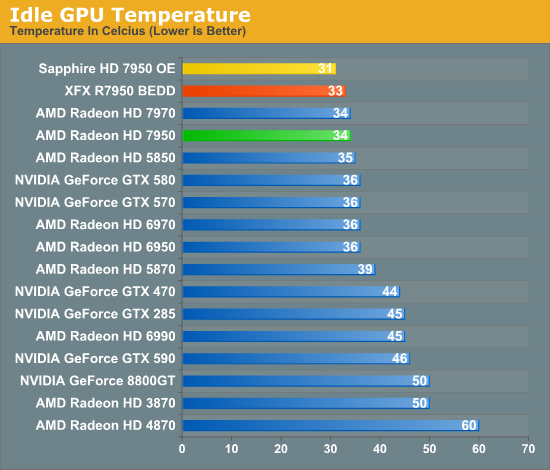
As the use of power islands has brought down the idle power consumption, so has it brought down idle temperatures. The 7970 already did well here and the reference 7950 does similarly well, while the open air coolers on the XFX and Sapphire cards take this one step further, pulling temperatures down to 33C and 31C respectively.
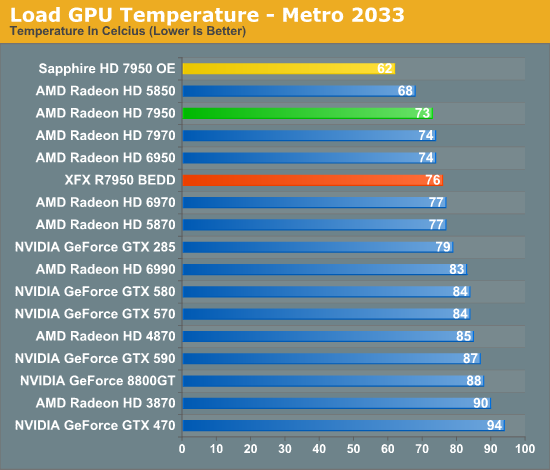
Meanwhile load temperatures are a mixed bag among the 7950s, and it’s not all good. Starting with the Sapphire 7950, we have an open air card with a very low VID that’s performing as we’d expect. The Sapphire card is extremely cool here, and this kind of gap is consistent with other near-200W cards we’ve seen in the past. Elsewhere, in the middle is the reference 7950, which is using AMD’s fully exhausting blower; this pushes almost all the heat outside of our case, but it does keep temperatures higher, and in this case very close to the 7970.
Finally we have the XFX card, which is the odd man out. The R7950 BEDD is an open air cooler and we’d expect performance closer to the Sapphire card, not performance worse than the reference 7950.

Under OCCT the results closely mirror what we saw with under Metro. The Sapphire is well in the lead among the 7950s, followed by the reference and XFX cards. With virtually every other card pushing 80C or higher, the 7950s are in good company here, particularly compared to the 88C GTX 580 due to the lack of comprehensive power throttling on NVIDIA’s part.
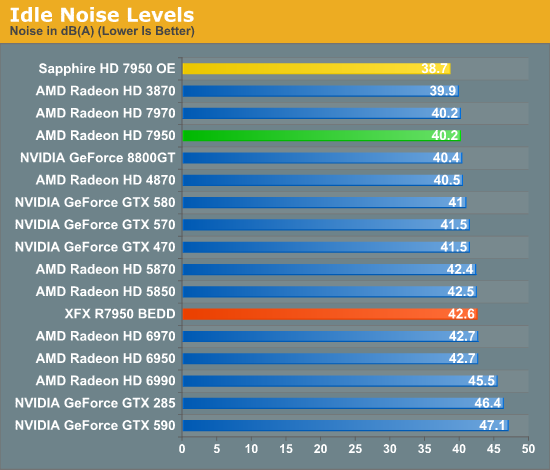
Last but not least we have our look at noise. The 7970’s cooler was already doing quite well at 40.2dB, but Sapphire takes this one step further with their open air cooler, bringing their idle noise down to 38.7dB. XFX on the other hand doesn’t fare as well, as their Double Dissipation cooler can’t rev down quite enough, coming in louder than the reference 7950 at 42.6dB.

It’s looking at load noise that particularly drives home the potential of the Sapphire 7950. Sapphire has exploited their open air cooler for all it's worth, and as a result it’s quieter under load with Metro than half our cards are at idle—41.3dB is only 0.3dB louder than the GTX 580 at idle, never mind the other 7950s. The XFX meanwhile fares really, really poorly here for an open air cooler. This doesn’t appear to be a matter of an aggressive fan profile as we’ve already seen that its temperatures are close to the reference 7950, so there’s more going on here.

Even under OCCT the Sapphire 7950 still only hits 42.8dB, a particularly impressive showing when you consider that AMD’s reference 6900 series cards idle at 42.7dB. It’s not a silent card, but for most practical purposes it’s damn close. Meanwhile the XFX 7950 again fares poorly, coming in at 56.8dB. This is still quieter than the GTX 580 in this case, but it’s clearly disappointing.
Wrapping things up, as we stated in our introduction the vast selection of 7950s means that there’s going to be a wide range of performance for 7950 cards, and these results drive home the point nicely. The Sapphire 7950 simply gushes potential—not only is it a factory overclocked card, but it gives off so little heat and noise compared to anything else in its performance class that it’s unrivaled. Much of this no doubt is due to the extremely low VID of our sample and I strongly suspect that this a better voltage than the bulk of Sapphire 7950s can actually hit, so our results are most likely better than average. Still, even with more voltage there’s still plenty of thermal and acoustic headroom for the Sapphire 7950 to work with, so it should still be a well performing card regardless.
Overall it’s results like what we’ve seen with the Sapphire that are a large part of why AMD’s partners are strongly favoring open air coolers. But with that said, that potential can only be reached in a case with good airflow, meaning that the Sapphire 7950 (or any other open air 7950 for that matter) is likely a poor choice for a cramped case. Furthermore all of these open air cards are poor choices for CrossFire if they need to be directly adjacent to each other. A lot of boards offer usable PCIe x16 slots farther away from their first x16 slot, but this is not the case for all boards. Ultimately the lack of 7950 cards using a fully exhausting blower is definitely going to limit the CrossFire potential of the 7950.
Finally, we have the XFX 7950 BEDD. The 7970 BEDD was a very impressive card; the 7950 BEDD is not. It’s not possible to completely isolate any specific reason for the 7950 BEDD’s poor performance, but the most likely factors are the GPU quality and the ability of the card to transfer heat between the GPU and heatsink. With regards to quality, if the Sapphire 7950 has among the best 7950 GPUs then the 7950 BEDD has an average GPU if not worse; 1.093v is the same as our reference cards, but there’s still room for quite a bit of variance. Whereas when we’re looking at heat transfer we have to look at the much smaller vapor chamber the 7950 BEDD uses compared to the 7970 BEDD, along with what at first glance looks like too much thermal paste.
Given our temperature and power consumption data we’re heavily favoring the heat transfer theory; the 7950 BEDD just isn’t very good at transferring heat from the GPU. This is not to say that the 7950 BEDD is a bad card—our results are reasonable for a 200W card—but we’ve seen much better in the 7970 BEDD, never mind the other 7950 cards.










259 Comments
View All Comments
MattM_Super - Tuesday, January 31, 2012 - link
Yes I would enjoy more performance (esp at a lower power draw). I like to get ~60fps minimum @1080p. In games with fancy lighting effects, 4xAA, high res textures, like Witcher 2, metro 2033, crysis 2 dx11 current cards cant deliver that. Its a luxury sure, but one I am willing to pay for.I also think there is still plenty of room for improvement in graphics.
sleepeeg3 - Wednesday, February 15, 2012 - link
Bingo. The fanboys are too focused on bickering to realize these GPUs are blowing past 100fps on popular games. Who cares? Game companies stopped pushing the limits years ago.chizow - Tuesday, January 31, 2012 - link
Its funny because next-gen single-GPU performance *USED* to be measured against previous gen x2 GPU card or CF/SLI where we would expect 50+% increase over last-gen single-GPU.But yes its easy to ignore the fact the 580 also overclocks quite well. I don't know what would be worst though for a new 7950 or 7970 owner. Kepler launching and make these prices look like tragic comedy, or AMD releasing the HD89xx not too long after to make them feel even worst about their purchase.
Either way, you make a compelling argument against buying one of these cards today.
Master_shake_ - Tuesday, January 31, 2012 - link
you are obviously a fanboy,obviously you missed the part where the 7970 can oc to 1125 on the cvore and max out the vram clock with STOCK voltiage, and when you do so it beats BEATS the gtx 590 a current gen dual gpu card.
chizow - Tuesday, January 31, 2012 - link
While I value OC'ability, I don't consider OC to stock comparisons relevant because frankly, it makes no sense.Every card can OC to some degree so an apples-to-apples comparison should be the primary comparison with overclockability secondary.
Tchamber - Wednesday, February 1, 2012 - link
Rather than call you a fanboy, I would ask for an example of a high end card going against the previous gen x2 card...and bear in mind that ONCE does NOT consitute a trend. I think evolution of performance is always incremental, at least is has been since gtx200 and radeon 4000 series.chizow - Wednesday, February 1, 2012 - link
-GTX 280 was very close to as fast as 9800GX2Filter prevented a link for this, but google computerbase GTX 280 review and look at performance rating summary.
-GTX 480/580 was faster than GTX 295
Same deal, google 480 review for that site.
-GTX 680 should be very close to GTX 590 performance
What makes this easier on the next-gen GPU flagship is the last-gen X2 parts generally have to make sacrifices in either bandwidth, functional units, or clockspeeds to stay within TDP envelopes along with imperfect multi-GPU scaling, so you generally see only 50-75% scaling over the top single-GPU of that generation.
So you can look at it two ways, either next-gen should be ~50% faster than the top last-gen GPU, or it is very close to the last-gen X2 GPU card.
I'm trying not to take any shots at AMD fans, but their reactions to these Tahiti parts in light of historical price and performance leads me to believe they either have very low standards/expectations or they just haven't been paying attention to the industry.
Galidou - Saturday, February 4, 2012 - link
''they just haven't been paying attention to the industry''Wait, if I buy a GPU now, and I want the top single gpu for multiple screens, whatever the people in the world think about what I WANT, I realize that I have more power for my money by buying a 7970 and I go with it, it turns out that because I have done that, I'm an AMD fanboy because I haven'T been paying attention to the industry?
OMG I'm such a tard, I forgot I haven'T paid attention to the industry so I should of paid more for a less performing card..... darn that's how stupid I am.....
chizow - Saturday, February 4, 2012 - link
If you absolutely had to have a new card today, sure you'd have some reason to buy a 7970, but still not at these prices imo.If you wanted to maximize your return on the dollar however, you'd be much better off waiting for Kepler because even if the 7970 still suits your needs better at that point, Kepler will almost assuredly force downward pressure on all Tahiti AND Fermi parts and force AMD and Nvidia to adjust prices accordingly. In the past AMD has done this when they launched a next-gen part first (See: 5850/5870 launch), but not this time.
This actually reminds me a lot of the X1950XTX launch. Great performance when it launched and price perfectly justified compared to Nvidia's last-gen G70/G71 designs like 7900GTX and 7950GT. But as soon as G80/8800GTX launched a few months later, it made that buy decision look horrible in retrospect.
So yes, while a X1950XTX today, er I mean 7970 today looks perfectly justified, it would be a mistake to ignore what the future holds and what the past has told us when making a buying decision.
Galidou - Sunday, February 5, 2012 - link
What about the pricing of gtx 280 at launch vs the price of 8800gt were selling? There's always an example about Ati making bad pricing decisions, but nvidia... not out of your mouth?I'm no ATI fanboy, I'm just waiting for you to show us you see the other side of the medal...
Those GTX 280 650$ at launch while the 8800gt was about 55-65% of the performance of that card but HEY it was three times cheaper... No you haven't heard of? Oh I forgot, Nvidia makes no mistakes, it's ATI that did with the 4870 pricing it so low, but Nvidia... they make no mistake.
But hey the price of the 7970 accordingly to it'S performance is SO BAD compared to the triple price of that GTX 280 for not even double the performance over that nice 8800gt...